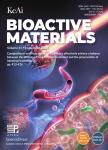Nanocellulose,a versatile platform:From the delivery of active molecules to tissue engineering applications
作者机构:Department of Biosystems EngineeringInstitute of Forest ScienceKangwon National UniversityChuncheon24341Republic of Korea Interdisciplinary Program in Smart AgricultureKangwon National UniversityChuncheon24341Republic of Korea Deptarment of Engineering DesignIndian Institute of TechnologyMadras600036India
出 版 物:《Bioactive Materials》 (生物活性材料(英文))
年 卷 期:2022年第7卷第3期
页 面:566-589页
核心收录:
学科分类:08[工学] 080501[工学-材料物理与化学] 0805[工学-材料科学与工程(可授工学、理学学位)] 080502[工学-材料学]
基 金:This research was supported by the Basic Research Program through the National Research Foundation of Korea(NRF)funded by the Ministry of Education(NRF-2018R1A6A1A03025582) and the National Research Foundation of Korea(NRF-2019R1D1A3A03103828)
主 题:Nanocellulose Chemical functionalization Drug delivery Protein delivery Plasmid delivery Tissue engineering
摘 要:Nanocellulose,a biopolymer,has received wide attention from researchers owing to its superior physicochemical properties,such as high mechanical strength,low density,biodegradability,and *** can be extracted from wide range of sources,including plants,bacteria,and *** on the extraction process and dimensions(diameter and length),they are categorized into three main types:cellulose nanocrystals(CNCs),cellulose nanofibrils(CNFs),and bacterial nanocellulose(BNC).CNCs are a highly crystalline and needle-like structure,whereas CNFs have both amorphous and crystalline regions in their *** is the purest form of *** nanocellulose properties can be tuned by chemical functionalization,which increases its applicability in biomedical *** review highlights the fabrication of different surface-modified nanocellulose to deliver active molecules,such as drugs,proteins,and ***-mediated delivery of active molecules is profoundly affected by its topographical structure and the interaction between the loaded molecules and *** applications of nanocellulose and its composites in tissue engineering have been ***,the review is concluded with further opportunities and challenges in nanocellulose-mediated delivery of active molecules.



